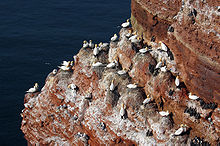Colony (biology)

In biology, a colony refers to distinct individual organisms of the same species living closely together, usually for mutual benefit, such as stronger defense or the ability to attack bigger prey. Individuals within a colony have all of the functions needed to survive and reproduce.[1] For example, protists such as slime molds are many unicellular organisms that aggregate to form colonies when food resources are hard to come by and eusocial insects like ants and honey bees are multicellular animals that live in colonies with a highly organized social structure.
Colonial organisms are composed of many physically connected, dependent individuals. Colonial organisms can be unicellular, as in the alga Volvox (a coenobium), or multicellular, as in the Phylum Bryozoa. The former type may have been the first step toward multicellular organisms.[2] Individuals within a multicellular colonial organism are called zooids, which are formed through asexual reproduction and are thus genetically identical. Structural and functional variation (polymorphism), when present, designates zooid responsibilities such as feeding, reproduction, and defense. To that end, being physically connected allows the colonial organism to distribute nutrients and energy obtained by feeding zooids throughout the colony.
A microbial colony is defined as a visible cluster of microorganisms growing on the surface of or within a solid medium, presumably cultured from a single cell.[3] Because the colony is clonal, with all organisms in it descending from a single ancestor (assuming no contamination), they are genetically identical, except for any mutations (which occur at low frequencies). Obtaining such genetically identical organisms (or pure strains) can be useful; this is done by spreading organisms on a culture plate and starting a new stock from a single resulting colony.
A biofilm is a colony of microorganisms often comprising several species, with properties and capabilities greater than the aggregate of capabilities of the individual organisms.
See also
- Ant colony
- Beehive (beekeeping)
- Bird colony
- Clonal colony
- Colonisation (biology)
- Coral reef
- Eusociality
- Superorganism
- Swarm
- Birth colony
- Austroplatypus incompertus
References
- ^ Jackson, J.B.C. (1977). "Competition on Marine Hard Substrata: The Adaptive Significance of Solitary and Colonial Strategies". The American Naturalist. 111 (980): 743–767. doi:10.1086/283203.
- ^ Alberts, Bruce; et al. (1994). Molecular Biology of the Cell (3rd ed.). New York: Garland Science. ISBN 0815316208. Retrieved 2014-06-11.
- ^ Tortora, Gerard J.; Berdell R., Funke; Christine L., Case (2009). Microbiology, An Introduction. Berlin: Benjamin Cummings. pp. 170–171. ISBN 0-321-58420-1.
